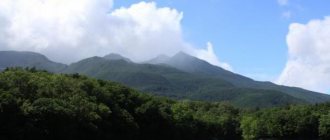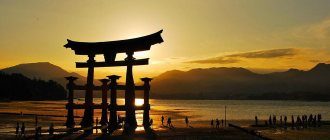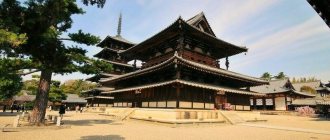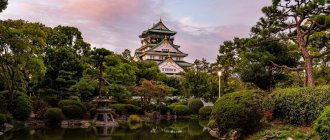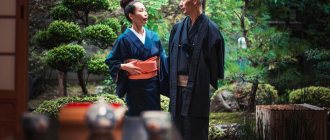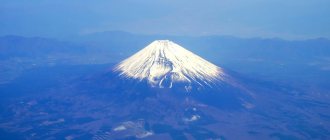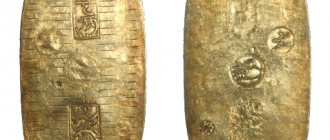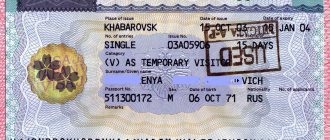Location
The state is located between the Sea of Okhotsk and the Pacific Ocean. The area is 377 thousand square meters. km. If we talk about coordinates, Japan lies 36 degrees north of the Equator and 136 degrees east of the Greenwich meridian. The largest islands of Japan are:
- Kyushu;
- Shikoku;
- Honshu;
- Hokkaido.
Japan has no land borders with other countries. The coastline of the state stretches for 29,751 km .
The border of the country, washed by the sea, is parallel to Russia, China, and the Republic of Korea.
Relief
Due to its geographical location, Japan has many slopes and mountain ranges. The terrain is mountainous, and most of the mountains are too dissected. Relief features also include the predominance of angular contours. On the islands of Kyushu and Honshu there are smoothed features, the coastal areas of Hokkaido are distinguished by the softness of the relief.
The highest mountain is Fuji. It is located in the center of the island of Honshu, west of Tokyo. Some peaks of this mountain reach a height of 3000 meters above sea level.
In the state, only 25% is occupied by plateaus and lowlands. There are also a huge number of reservoirs and rivers on the territory, which complicates the construction of urban infrastructure.
The longest river is the Shinano. It reaches 367 km in length.
Lesson “General characteristics of Japan”
Lesson topic "Japan"
Goals:
- Forming an idea about the role and place of Japan in the world economy, about the factors that determine the most important economic and geographical features of modern Japan.
- Expanding geographical knowledge and horizons on the topic “Japan”.
- Introduction to the “Japanese model” of economic development;
- Formation of moral values and aesthetic attitude towards elements of living and inanimate nature as the source of life, beauty, and spiritual culture of the Japanese people.
- Determining Japan's contribution to world culture.
Equipment:
economic map of Japan, flag of Japan, sayings in Japanese, business card (filled out together with children), literature about Japan, paintings by Japanese artists, tea ceremony dishes, cups for sake, soup, rice, chopsticks and other tableware, kimonos and clothing items, religious objects, ikebana, bonsai, Japanese art objects, television and video equipment.
Oh, here it is - a wonderful country, my cherished land - Akitsushima! The islands are spread out like the wings of a dragonfly, the Land of Yamato - here it is!
Matsuo Basho
- Hello! Sayonari! Today we have an unusual lesson. We will try to immerse ourselves in the world of another people. We will visit a country that is very strangely called “The Country in Reverse”. And there is every reason for this. In this amazing country, a woman gives coats, the steering wheel in the car is on the right side, cats are tailless, here they write from top to bottom, eat with chopsticks, sleep on the floor, and white is the color of mourning. So what kind of country is this – Japan? I want to ask you for help now. Because in fact, you know so much without realizing it. You have cards on your tables ( Appendix 1
). Please think and write:
1 noun 1 adjective 1 verb 1 sentence that you associate with the word Japan.
Post the words on the board
– Look how much you know, we can call these words symbols of Japan. So what can we look at today in class?
Refer to goals.
Japan is our neighbor. Only narrow strings of sea straits separate the territories of our countries. 43 km separate the island of Hokkaido from the island of Sakhalin and only 5 km from the nearest island of the Kuril chain. Let's make a business card for our neighbor. There is a folder in front of you. Open it, please. Take a piece of business card and try to fill it out.
Filling out a business card.
(
Appendix 2
)
Name:
Japan;
Territory type:
island state;
Composition of the territory:
4 large islands (Hokkaido, Honshu, Kyushu, Shikoku) and 4000 small islands.
All islands are connected to each other by bridges and tunnels. Length from north to south:
3500 km;
Area:
372.2 thousand km2
Population:
125.5 million people;
Official language:
Japanese;
Capital:
Tokyo;
Currency:
Yen;
UN member:
since 1956
Flag:
red circle representing the sun;
Form of government:
constitutional monarchy;
Head of State:
Emperor;
Supreme legislative body:
parliament;
Government structure:
unitary state;
National composition:
99% Japanese;
Religious composition:
Shintoism - 76%, Buddhism - 16%.
Many researchers, having visited Japan, consider the Japanese to be atheists, and the Russian traveler G. Vostokov wrote about it this way: “...If you ask a Japanese what his faith is, he will not understand you. All he can tell you is that, according to custom, he was given a name in a Shinto shrine and that, probably, Buddhist bonzes will accompany him at his funeral, between these extreme points he can easily become a Christian." Literacy level:
100% (from Japanese teachers , psychologists and doctors have a method by which they teach children with severe developmental delays);
Average life expectancy:
76 years for men, 82 years for women. There are 610 people per doctor in Japan. What are the reasons for the longevity of the Japanese:
- The freshest products;
- Attitude to life (value life and protect nature);
- Goodwill;
- Walking habit (there is a 10,000 steps to health program in the country);
- Hygiene.
Average population density:
336 people/km2, and along the Pacific coast from 1 to 8 people/m2;
Urbanization:
77%;
National flower:
round chrysanthemum;
National Symbol:
Fuji (a student's story about a mountain);
Mountains:
75% of the territory;
Forests:
70% of the territory (most of them artificial):
Washed by:
the Pacific Ocean, the Sea of Okhotsk, the Sea of Japan and the South China Sea.
Japan is a mountainous country; to expand living space, the Japanese create artificial islands and peninsulas, filling up the adjacent water area. The country's territory is subject to high seismic activity, with up to 1,500 earthquakes of varying strengths per year. Volcanic eruptions are associated with tsunami waves caused by them, causing great damage to the economy, especially about. Honshu and Fr. Hokkaido. Japan is poor in mineral resources. There are relatively small reserves of sulfur, copper, coal, iron ore, rare metals, and rock salt. The climate of Japan is favorable for people's lives and farming. An important factor shaping the climate is the monsoon. The rivers are full of water. They are a source of electricity, but are not suitable for shipping. Japan is a country at the post-industrial stage of development. How, with such meager resources, did Japan become the economic leader in the modern world? What caused Japan's "economic miracle"? What is the “Japanese model” of economic development?
Working with supports on the board
- Development of a carefully thought-out national strategy for economic development, taking into account local conditions, when the entire adult population was involved in economic activities.
- A combination of large mass production with many small enterprises - suppliers.
- At the initial stage of economic development, in order not to waste time on research and development and the introduction of new discoveries into production, Japanese entrepreneurs relied on the import of foreign thought. The Japanese willingly bought patents and licenses from other countries, but did not allow foreigners into their enterprises.
- The Japanese produce only those products that are in demand on the world market.
- Investment of capital in knowledge-intensive production. 19 technopolises have been created in Japan.
- Limitation of military spending, because After 1945, Japan cannot have an army.
- Japanese education system. Studying in Japan is prestigious. Japanese people start learning from the age of 5. Admission to a prestigious university is considered important. For this purpose, students, in addition to general education schools, also study in “immersion” schools. They are so tired from studying that they sometimes sleep in class. If the child does not go to university, he or she goes back to the immersion school and goes back to university. Japan has universal higher education. In terms of education, Japan ranks 1st in the world.
- Relatively cheap labor combined with high production technologies. Remuneration depends on the quality of the products produced.
- Traditional Japanese hard work. A Japanese chooses a company for life. Salary depends on length of service. The company provides employees with housing, medical care, and pensions. People take pride in their work and tend to have a genuine attachment to the company they work for. In order not to look like slackers, the Japanese do not take vacations and owners are forced to close enterprises while their employees are on vacation.
– Let's look at what sectors of the economy are developed in Japan. Here is an economic map of Japan. What industries do you think we can call specialization industries?
Students answer:
- Mechanical engineering and metalworking;
- Electrical Engineering;
- Shipbuilding;
- Automotive industry;
- Ferrous metallurgy;
- Chemical industry;
- Oil refining;
- Food industry;
- Light industry;
- Forestry and woodworking industry.
– Name the centers of industrial production in the country?
- Tokyo;
- Osaka;
- Yokohama;
- Nagasaki;
- Nagoya,
- Kitakyushu;
- Sapporo;
- Fukuoka.
– Look carefully at the map. What features of the location of large industrial centers do you see?
Student response:
The entire territory of Japan can be divided into 2 parts: southern, southeastern, which is called the “front part”, where most of the production is located. And the northern, northwestern part is the “rear part”, which does not have such a high concentration of production and is a more environmentally friendly territory. An important feature of the economy is international economic relations, since 9/10 of the economy is import-oriented.
– Open page 192, Figure 69 in the textbook. Let's look at the export and import scheme. What goods are imported into Japan, and what goods does Japan export?
Working with a diagram in a textbook
The Japanese are a mystery of our century; they are the most incomprehensible, the most paradoxical of peoples. They are not like any other people in the world. These are the most sensitive, lively, artistic natures and at the same time the most imperturbable, impractical, silent people. The Japanese nation originated from the Ainu who came here from the Far East. Japan was isolated from the rest of the world for many centuries and therefore retained its identity and originality. The Japanese sacredly revere ancient rituals and traditions, which include honoring elders, kimonos, features of Japanese cuisine, table setting, tea ceremony, ikebana, bonsai, origami, etc.
The guys give presentations that they prepared additionally, having received an advanced task.
Bow
Treating each other kindly is very important to the Japanese. This is expressed primarily in bowing. The Japanese customarily bow and smile. A subordinate bows to his boss, bending his body at an angle of 45?, colleagues bow to each other at an angle of 15?, meet clients at an angle of 30?, a student bows to a teacher at an angle of 48? and if a student grows up and becomes, for example, the prime minister of a country, when he meets a teacher he bows at the same angle - that means everyone has their own “angle.” Also, when the mother, according to Japanese custom, carries the baby on her back, she forces him to bow with each bow, thereby giving the first lessons in honoring elders.
Tea party
Tea drinking in Japan is a whole ritual called “cha-nu-yu”, which means “tea ceremony”. No more than 5 people participate in the ceremony. The room should be twilight even during the day, and all the furniture and objects in it should be antique, only the snow-white linen scarf and bamboo ladle are emphatically new. All ceremony participants sit on the floor. One of them pours powder into a cup - green tea ground into powder, pours boiling water over it and whips up the foam with a special bamboo whisk. The ceremony takes place in complete silence. Particular attention is paid to water quality. Contemplation of the world is one of the characteristics of the Japanese people. This includes growing bonsai and creating ikebana.
Bonsai
There are real miracles in Japan. One of them is bonsai - miniature gardens. These are small gardens, but their size does not exceed the size of a room. Dwarf trees grow in them: oaks, maples, larches up to 30 centimeters high. Several generations of people have been growing them for more than 900 years, and they are passed on by inheritance. The Japanese can spend hours admiring such gardens, spending all their free time around them in thought, resting from a hard day of work. The existence of such a kindergarten can be explained by the desire of people to experience the beauty of the big world, to have it next to them.
Ikebana
Ikebana is a rough translation of the art of arranging flowers. This is a whole science. It is taught in special schools. This art is taught from the age of 6, three times a week. Penetrating into the world of ikebana requires a person to have professional knowledge and a special gift - a subtle visual perception of its subtle properties. It is based on three lines symbolizing Heaven. Man and Earth. Ikebana is not just a bouquet - it is a symbol.
Kimono
Kimono is translated from Japanese as clothing. Kimono is the Japanese national costume. Even today, on holidays, everyone, young and old, wears it. It is inherited, the same for everyone: there is no difference - male or female. Kimono is a garment that is never thrown away.
- Let's see what a Japanese house looks like.
Japanese house
Earthquakes often occur in Japan, so they build houses here that do not cause people to die when destroyed.
Watch video.
The houses are made of light wooden slats. The walls slide open like bookcase doors. This allows you to easily and quickly change the layout of your home; the floors are covered with special mats made of pressed rice straw. During the day they sit and dine on them, and at night they sleep. There is usually little furniture. The house is perfectly clean. Guests will come, the hosts will invite them to the table. Each person will be served two chopsticks instead of a fork. In Japan, 11.3 billion wooden chopsticks are purchased annually, used only once, and then thrown away. Instead of chairs there are soft cushions. The dishes on the table have nothing to do with that. What do we call services? Visitors are surprised at the discrepancy. And to the Japanese it seems bad taste to have the same painting on plates and cups. And when the guests leave, the owners will give them a crane bird. Counts. That he will bring happiness to people.
Students hand out cranes to guests.
The crane today has become not only a symbol of happiness. After the tragedy in the cities of Hiroshima and Nagasaki, he also became a symbol of hope. Japanese philosophy is also interesting. For example, the Japanese writer Sei Shonagon wrote “Makuro no soshi” (notes at the headboard) in 996. The Japanese still hang such notes at the head of their bed.
(Give examples of such statements. Offer to choose the one that you would hang at your headboards.)
– Traditions in Japan are preserved thanks to the unique upbringing of their children. Raising a child is divided into 3 stages:
Stage 1 – up to 5 years. The child is a “god” - he is allowed to do everything, because... the child discovers the world. Stage 2 – up to 14 years. A child is a “slave” - he must obey his parents unquestioningly. Because he learns to be efficient. Stage 3 – from 14 years old. A child is a “friend” - his opinion is taken into account, he is consulted, because he learns to be independent.
– In today’s lesson we visited one of the most amazing corners of our planet, an amazing country. In which people, in defiance of nature, which did not give them sufficient mineral resources or land, reached such economic heights that many on earth could envy them.
– Guys, you have tests on your tables that have a hieroglyph of different colors in the corner (blue, yellow, green, red, orange). You can choose any one.
Testing is underway.
Ask the guys from one of the groups to check the tests, sorting them by color.
Homework:
Topic 7, § 3.
Additional task of students' choice:
- What would you call Japan's "Economic Heart" and why?
- What is unique about the Land of the Rising Sun?
- Is the Japanese “economic miracle” over?
Summarizing
Turn to goals. Do the students think we have completed them?
Grading.
- Our lesson is over. Thank you for your work. Konnichiwa! Goodbye!
Natural features
The country is characterized by a temperate and subtropical climate. Hokkaido and the northern part of Honshu are under the influence of moderate air masses, and the islands in the south of the country are in the subtropical zone. An impressive part of the land is occupied by broad-leaved evergreen forests. In the north of the republic there is predominantly taiga, and in the south there are mixed forest zones.
There are small coal deposits on the island. There are also frequent deposits of oil and mineral resources. In addition, the republic has large deposits of sulfuric acid.
Holidays, traditions and events
In addition to your favorite type of tourism, a visit to Japan can be timed to coincide with a specific local holiday or festival. The Japanese celebrate holidays on a grand scale, with dancing, processions and fireworks. Each of these events is a unique event that requires special attention from tourists, and some even active participation. There are a huge number of such days, but some of them are especially grandiose and unusual.
Hadaka (Okayama City)
On this day, you can see men around the city without clothes, except for a loincloth, running around in search of luck.
Kanamara (Kawasaki)
The holiday is dedicated to the male penis. Exhibitions, processions and competitions are organized for the most unusual and largest figure of the phallus.
Tanabata
This event is related to astronomy. It is celebrated in every city. On the trees you can find colorful ribbons and pieces of paper with secret desires, poems and wishes for the future.
- Snow Figure Festival (Sapporo);
- Jidai (Kyoto);
In the mass procession one can see the revival of many eras. People visualize the history of Japan's development, conveying it through dances, costumes and performances.
Tenjin Matsuri (Osaka)
The holiday is accompanied by a legendary boat parade and a fire show with fireworks.
There are still a lot of holidays in Japan, and each of them is unique. Therefore, while staying in the country, travelers will not only be able to visit the sights or engage in an interesting way of relaxation, but they will also definitely be able to catch one of the bright shows and get a storm of delight and indescribable emotions.
